Analyzing Four Centres the Canucks Could Target

By Harman Dayal
5 years agoThe reality of life after the Sedins is finally starting to set in and it’s a grim one to be sure.
Say what you want about their decline, but the Twins were productive offensive players to the very end of their careers, combining for 105 points in 2017/18.
In the short term, Henrik’s loss has left the Canucks with a massive hole down the middle. After Bo Horvat and Brandon Sutter, the team lacks bonafide NHL centres. Adam Gaudette could very well join the mix next season, but it’s unfair to lean on him for top-nine production in his rookie campaign. Top prospect Elias Pettersson is expected to be with Vancouver for the upcoming season — though it’s more likely he starts at right wing given his thin frame and inexperience playing centre against men.
The odds are that the team will need to turn to either the trade or free-agency market to find a middle-six centre. There are a few avenues that Vancouver could explore within these markets, but the key is to fulfill the need without sacrificing assets that might inhibit the rebuild. With that in mind, here are four centres the Canucks should target.
Lucas Wallmark
Age: 22
Frame: 6-feet, 176 pounds
Stats:

If there’s one thing Vegas has taught is, it’s that some players just need a chance in the right circumstances to break out. One of those hidden gems could very well be Carolina Hurricanes centre Lucas Wallmark.

Ian Tulloch did a study in a piece for The Athletic which broke down the career paths of elite 22-25-year-old AHL players from 2005 to 2015. Of the 46 players that averaged 1.10 points per game or above, 54.3% of them went on to become top-nine NHL players.
Wallmark has yet to find success at the NHL level, though it hasn’t helped that he averaged less than 10 minutes per game in the 11 appearances he made for the Hurricanes this season.
Part of the reason Wallmark saw such a limited role was because the Hurricanes primarily saw him as a defence-first player. It’s true that he has the face-off talent and defensive smarts away from the puck to be a reliable two-way centre, but his statistical resume indicates he has a lot more to give offensively. It’s up to Carolina to put him in a position to do so, but they’re already loaded down the middle with Sebastian Aho, Jordan Staal, Victor Rask and incoming 2017 first-round pick Martin Necas.
Offensively, Wallmark’s skating ability has been highlighted by many as an area needing improvement, but he’s still able to contribute because of his high-end vision, slick hands and passing precision. A playmaking package of that pedigree could prove to be lethal in an attacking role similar to one the Canucks can offer.
Does Wallmark Make Sense For the Canucks?
Wallmark represents a terrific opportunity to take advantage of an apparent market inefficiency revolving around young, elite AHL players lacking pedigree. Acquiring the 22-year-old Swede would be a low-risk move that entails roughly a one-in-two chance of eventually finding a top-nine NHL centre.
With Wallmark stuck behind established players on Carolina’s depth chart, it’s hard to imagine him getting an opportunity to prove his worth anytime soon. Given their surplus of talent up the middle, I’d suspect the Hurricanes’ asking price to be a mid-round pick or B level prospect — a cost that could wind up yielding tremendous value down the line.
I wouldn’t expect someone like Wallmark to transition to a full-time middle-six role seamlessly, but his cheap cost means you can find alternative options in the offseason to provide additional competition.
Nick Shore
Age: 25
Frame: 6-foot-1, 194 pounds
Stats:

An underappreciated centre who could also provide great value is unrestricted free-agent Nick Shore. The 25-year-old centre was in a similar situation to Wallmark three years ago — 22 and scoring above 1.10 points per game in the AHL.
As Shore graduated to the NHL, he was also perceived as a defence-first pivot and with good reason. He’s excellent at suppressing shot attempts and controlling possession.

Unrecognized when looking at Nick Shore’s performance is the elite rate at which he generated shot assists.
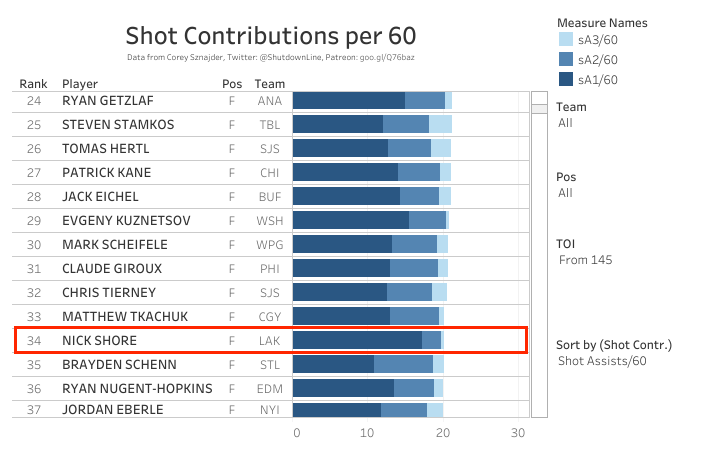
Shot assists are recorded each time a player makes a pass that leads to a shot on goal. One might attribute Shore’s performance to small sample size, but data tracked since 2014 portrays similar playmaking proficiency.
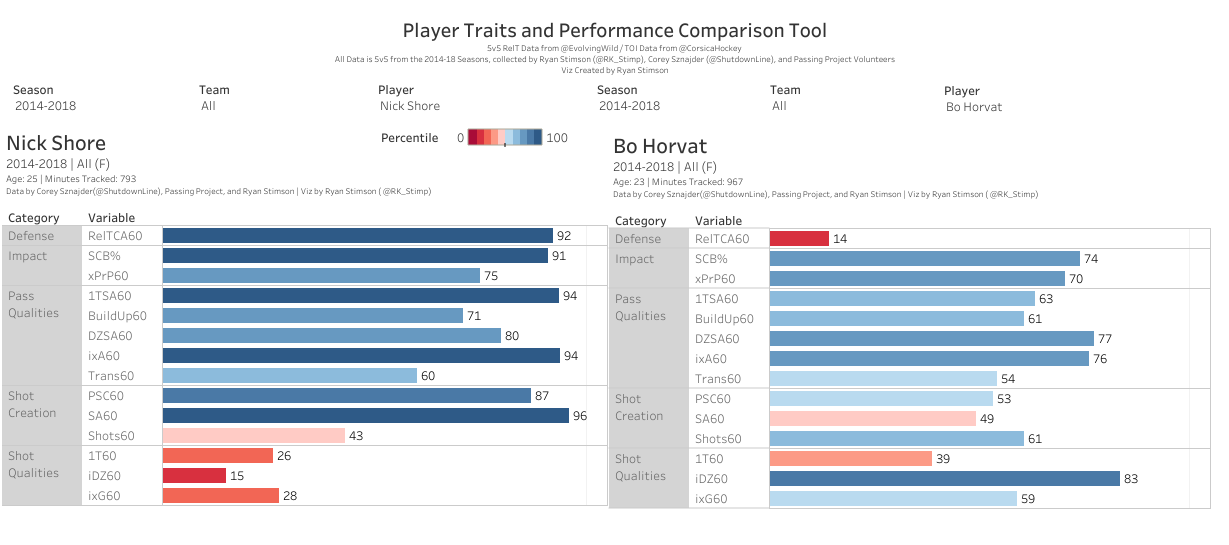
Shore is among the top 20th percentile of NHL forwards since the 2014-15 season when looking at the rate at which he generates shot assists(SA60), danger zone shot assists(DZSA60) and expected assists(ixA60).
His lack of production simply boils down to the linemates with which he’s played. No offence to his most common teammates this season with the Kings in Trevor Lewis and Andy Anderoff, but neither of those guys are capable of regularly converting on high danger scoring chances. Give Shore competent top-nine players on his wings and I’m sure he’d show a lot better than his track record to date might indicate.
Does Shore Make Sense For the Canucks?
Shore would be an excellent value addition to bolster the Canucks’ centre ice depth. Even if he fails to deliver offence in a top-nine role, he has the defensive plaudits in both the faceoff dot and penalty kill to be a valuable bottom-six centre. Further icing on the cake is that he’d cost nothing but cap space to acquire.
Victor Rask
Age: 25
Frame: 6-foot-2, 201 pounds
Stats:

If there’s a silver lining amidst the grief surrounding the Sedins’ retirement, it has to be the cap space gained. According to CapFriendly, the Canucks are projected to have roughly 24 million dollars of wiggle room, with RFAs Sven Baertschi, Troy Stecher and Jake Virtanen left to sign.
The Canucks are amenable to the notion of leveraging that financial flexibility, but as our own JD Burke outlined in a piece for The Athletic, it’s not in the traditional sense.
Instead of prying future assets to take on undesirable contracts, they’re more likely to acquire serviceable players delivering results not commensurate with their contracts. The end result is a cheaper cost relative to the market value for that player.
One option which fits that criteria is Hurricanes’ centre, Victor Rask.
The Breakdown
As mentioned when discussing Wallmark, Carolina is chock full of top-nine centres with Aho, Staal and Necas in addition to Rask.
With a disappointing 2017/18 season, Rask appears to be the odd man out in the group. Further souring the situation is that the 25-year-old Swede has four more years left on a contract carrying a $4-million AAV and a limited no-trade clause that kicks in for the final two years. He doesn’t offer the two-way chops of Staal, nor does he have the potential of Necas or Aho, so it’s easy to picture why a small market team like the Hurricanes might be eager to shed salary and move Rask out.
It’s an assertion that The Athletic’s Corey Sznajder echoed in a conversation with CanucksArmy — someone who’s followed Carolina very closely the past few seasons.
I think they’re at the point where they might want to dump Rask’s contract for a couple picks. He had an awful season and they don’t really view him as essential right now. I think if the Canes can get any future assets for him it’s good. Moving the contract in general seems to be the goal right now, though.
Add concerns about competitiveness, and it should come as no surprise that Rask’s name has already surfaced in the rumour mills.
All that shouldn’t take away from the fact that Rask remains a highly productive middle-six centre. He ranks 70th among all NHL centres when looking at points over the last three seasons. For reference, Bo Horvat is 52nd among that cohort — a group that also includes at least a handful of listed centres that don’t play up the middle.
The difference when examining his underwhelming production this season was that he didn’t have Jeff Skinner on his left-wing to convert on the chances he created. Instead, Rask’s most common left winger this season was Brock McGinn. Vancouver certainly wouldn’t provide much of an upgrade regarding linemate quality, so I’d think it would be unreasonable to expect Rask to get back to the 45+ point levels he reached earlier in his career.
Where Rask’s playmaking acumen would really benefit the Canucks, though, is on the power play. His 4.32 points per hour rate over the past three seasons on the man advantage are ahead of Henrik Sedin and just 0.05 points behind Horvat. With both Sedins and Thomas Vanek departing, the Canucks desperately need someone like Rask to distribute the puck and make plays with the extra man.
Does Rask Make Sense For the Canucks?
Long-term commitment becomes the issue with Rask. Between the high acquisition cost relative to the other options and his lengthy contract, Vancouver would likely be stuck with Rask for the foreseeable future should they trade for him. This means the Canucks need to be confident in his ability to centre the team’s second or third line as the new core emerges.
I like Rask as a stop-gap, but I’m skeptical of his value as a second-line centre moving forward.
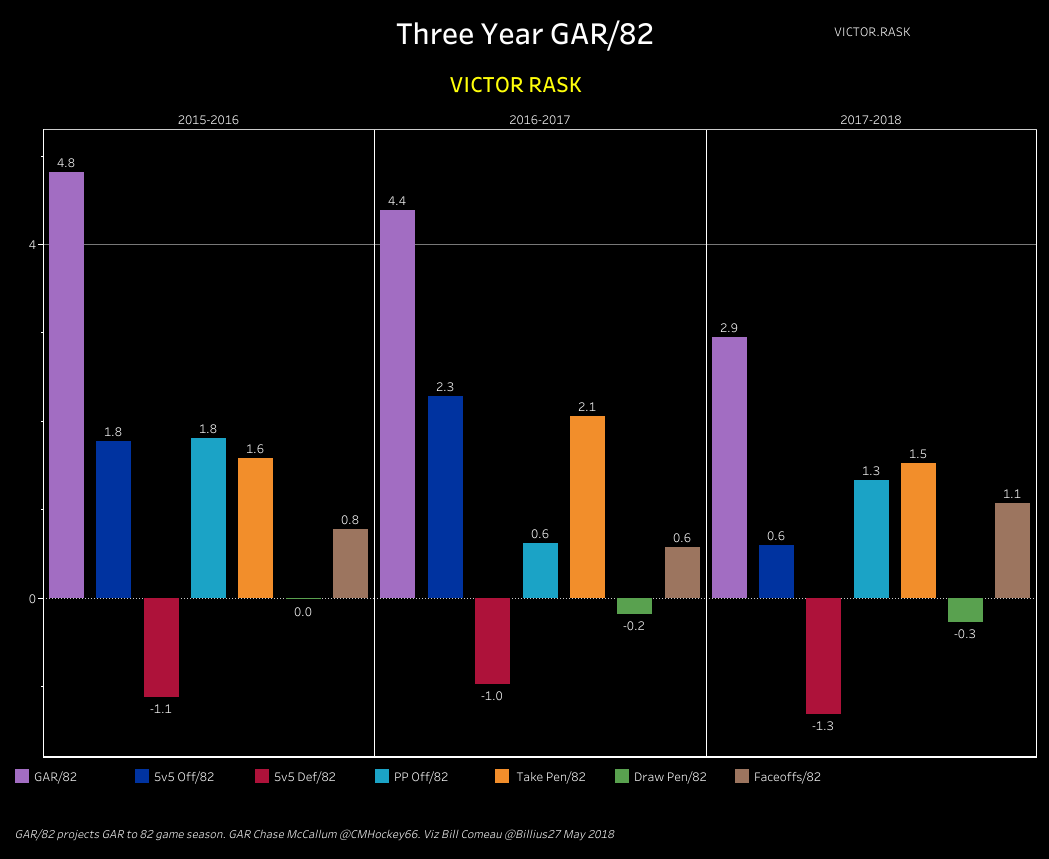
Goals above replacement (GAR) aims to consolidate performance in all facets of the game using both on-ice analytics and raw production at even-strength and the powerplay into a single, composite figure.
In Rask’s case, his GAR value highlights his substandard defensive play and mediocre influence on driving even-strength offence. In fact, if you analyze his 2016/17 performance, you’ll find that it’s eerily similar to Sam Gagner’s contributions this year.

Rask plays the premium position and faces tougher deployment, but there isn’t all that much separating the two.
All this is to say that I don’t see how he might fit into the group two or three years down the line when prospects like Pettersson and Adam Gaudette have hopefully established themselves as top-nine centres as well. Acquiring a long-term solution up the middle might make sense if it could afford Pettersson to shift to the wing permanently, but as the data above can attest, Rask isn’t good enough to anchor a top-two line vacancy that Pettersson would leave if moved from centre.
The other stipulation at the moment is the cost to acquire Rask in the first place. According to The Athletic’s Pierre LeBrun, Carolina asked for a pair of second-round picks from Montreal for Rask. One can expect that price to fall over time, but at the very least you’re looking at building a package around an upper echelon B-level prospect like Kole Lind.
Given that a long-term fit is questionable, I’d pursue some of the other names on this list before investing future assets into someone like Rask.
Sam Reinhart
Age: 22
Frame: 6-foot-2, 201 pounds
Stats:
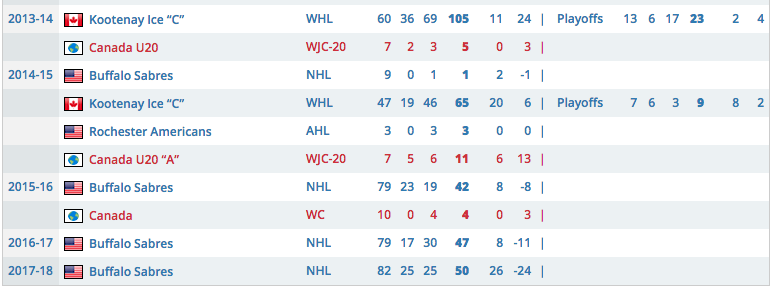
Similar to Carolina, the Sabres have a wealth of top-nine centres with Jack Eichel, Ryan O’Reilly and Casey Mittelstadt. Should the Sabres hang on to O’Reilly, they could conceivably shop Reinhart to address other needs to expedite their rebuild.
The Breakdown
For Reinhart, 2017/18 was another year of ups and downs. The former second overall pick notched just 13 points in his first 44 games before closing out the season with 37 in 38 games to reach 50 points for the first time in his career.
A beaming positive amidst his streaky offensive production was the quality defensive performance that Reinhart delivered.
| Sam Reinhart 2017-18 | |
| Defensive GAR | 3.1(89th percentile) |
| RelT CA/60 | -5.6(86th percentile) |
| RelT xGF% | +4.3%(82nd percentile) |
The 22-year-old was among the top 20% of NHL forwards when looking at defensive goals above replacement, suppressing shot attempts relative to teammates and expected goals for percentage relative to his team.
Unlike Rask, Reinhart looks the part of a long-term bonafide top-six centre. This is important for the Canucks because it means the Canucks could still own a respectable one-two punch up the middle with Horvat and Reinhart in a case where Pettersson is better suited for the wing. Reinhart himself will need to shift back to the middle after recent games on the right side, but his experience as a pivot should make any transition relatively seamless.
In fact, I’d argue that a switch to centre would give Reinhart more touches with the puck in dangerous offensive positions.
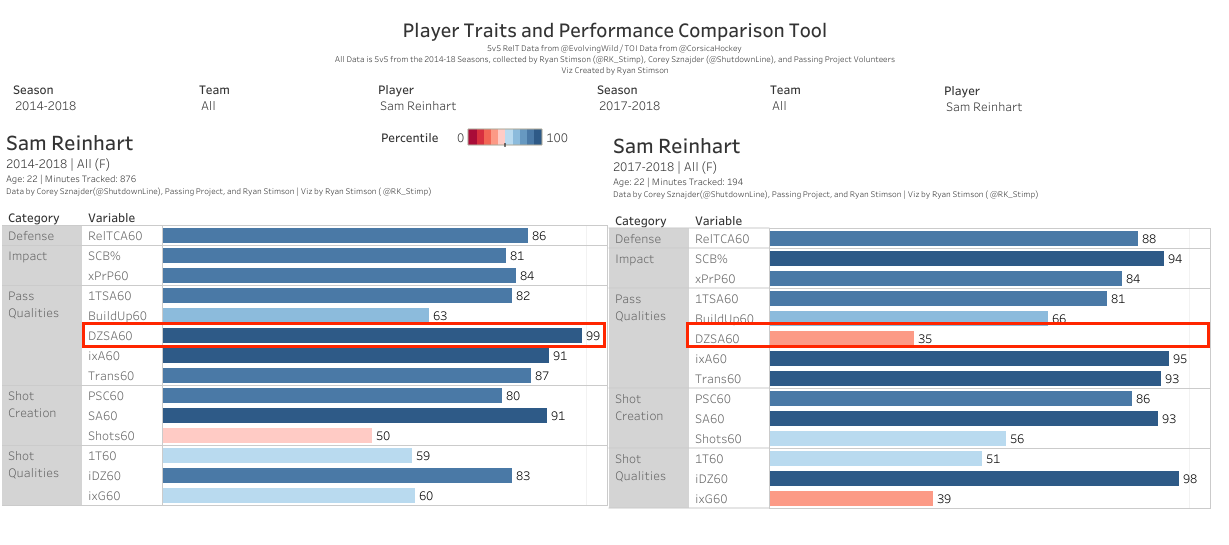
Cumulative data since the 2014/15 season pegs Reinhart among the 99th percentile for danger zone shot assists per hour, but that rate slipped heavily in 2017/18. I’d like to think a switch back to centre would give him the ideal touches to reverse that trend.
Overall, Reinhart is blossoming into a valuable two-way forward who can deliver top-six offensive production.
Does Reinhart Make Sense For the Canucks?
Quality young players come with hefty price tags, and Reinhart would be no exception. No other player on this list would come close to costing as much as Reinhart in a trade, but fortunately for the Canucks, the expendable assets they own align perfectly with Buffalo’s needs.
After Rasmus Ristolainen the Sabres have very little in the way of steady right-handed defencemen. A player like Chris Tanev would be highly beneficial because it would give Buffalo an ideal stay-at-home blueliner to pair with Rasmus Dahlin, in addition to freeing the much-maligned Ristolainen from significant defensive duties.
Should a package centred around Tanev be insufficient for coaxing Reinhart from Buffalo, Vancouver could also include Sven Baertschi. The 25-year-old left-winger may not be the most highly sought after commodity, but he’d be an excellent fit on a Sabres’ roster that has but one established top-9 left winger in the recently acquired Conor Sheary.
The ends would certainly justify the means in a Reinhart trade when considering how well he’d mesh with the Canucks’ emerging core.
Conclusion
There are two approaches the Canucks should consider with regards to bolstering their centre ice depth. The first would be to seek a stop-gap solution, in which case, it’d be wise to gamble on a couple of cheap pivots like Lucas Wallmark and Nick Shore.
Alternatively, the team could also search for a young but established NHL centre. Acquiring players that fit this bill, such as Victor Rask and Sam Reinhart, would cost more but it could end up well worth it if they can fit into the team’s long-term plans.
Recent articles from Harman Dayal





